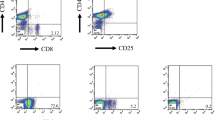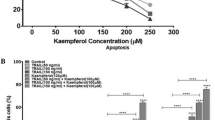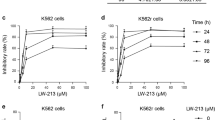Abstract
Indomethacin (IN) can inhibit cyclooxygenase activity and is considered to exert antitumor action in a variety of cancer cells. In the present study, we investigated the underlying mechanism of its antiproliferative effect on chronic myeloid leukemia (CML) cells. We studied the role of signal transducer and activator of transcription 1 or 5 (STAT1 or STAT5) and Bcl-XL proteins in IN-induced proliferative inhibition on CML cells. Both K562 cells and fresh bone marrow mononuclear cells from five CML patients were exposed to IN. Cell proliferation was determined by MTT assay. The expression of JAK2, STAT1, STAT5, and Bcl-XL proteins was probed with Western blotting. The level of phosphorylated STAT1 (p-STAT1) or STAT5 (p-STAT5) proteins was determined by coimmunoprecipitation combined with Western blotting. Intracellular localizations of both STAT1/STAT5 and p-STAT1/p-STAT5 were observed by indirect immunofluorescence assay. Our results showed that IN could inhibit the proliferation of CML cells in a dose-dependent manner (36–288 μg/ml). The expression of STAT1 and STAT5 was suppressed by IN both in a concentration-dependent manner and a time-dependent (0–36 h) manner. The levels of p-STAT1 and p-STAT5 were down-regulated by IN. A similar result was obtained for Bcl-XL protein expression. The intracellular fluorescence signals representing STAT1/STAT5 and p-STAT1/p-STAT5 were obviously weakened by IN. In contrast with IN, granulocyte-macrophage colony-stimulating factor could significantly promote the growth of CML cells and up-regulate the expression of both STAT1/STAT5 and p-STAT1/p-STAT5. This data indicated that IN is able to suppress the proliferation of CML cells, and the mechanism is associated with the inhibition of STATs/ Bcl-XL signal transduction pathway.






Similar content being viewed by others
References
Cortez D, Kadiec L, Pendergast AM (1995) Structure and signal requirement for BCR/ABL-mediated transformation and inhibition of apoptosis. Mol Cell Biol 15:5531–5541
Mandanas RA, Leibowitz DS, Gharehbaghi K, Tauchi T, Burgess GS, Miyazawa K, Jayaram HN, Boswell HS (1993) Role of P21 RAS in p210 bcr-abl transformation of murine myeloid cells. Blood 82:1838–1847
Skorski T, Nieborowska-Skorska M, Wlodarski P, Wasik M, Trotta R, Kanakaraj P, Salomoni P, Antonyak M, Martinez R, Majewski M, Wong A, Perussia B, Calabretta B (1998) The SH3 domain contributes to BCR/ABL-dependent leukemogenesis in vivo: role in adhesion, invasion and homing. Blood 91:404–407
Sillaber C, Gesbert F, Frank DA, Scatter M, Griffin JD (1999) STAT5 activation contributes to growth and viability in BCR/Abl-transformed cells. Blood 95:2118–2125
Mui AL-F, Wakao H, O’Farrel A-M, Harada N, Miyajima A (1995) Interleukin-3, granulocyte-macrophage colony stimulating factor and interleukin-5 transduce signal through two STAT5 homologs. EMBO J 14:1166–1175
Quelle FW, Sato N, Wittuhn BA, Inhorn RC, Eder M, Miyajima A, Griffin JD, Ihle JN (1994) JAK2 associates with the beta c chain of the receptor for granulocyte-macrophage colony stimulating factor, and its activation requires the membrane proximal region. Mol Cell Biol 14:4335–4341
Aaronson DS, Horvath CM (2002) A road map for those who know JAK-STAT. Science 296:1653–1655
Kisseleva T, Bhattacharya S, Braunstein J, Schindler CW (2002) Signaling through the JAK/STAT pathway, recent advances and future challenges. Gene 285:1–24
Rane SG, Reddy EP (2002) JAKs, STATs and Src kinases in hematopoiesis. Oncogene 21:3334–3358
De Groot RP, Raaijmakers JA, Lammers JW, Koenderman L (2000) STAT5-dependent cyclin D, and Bcl-xl expression in Bcr/Abl transformed cells. Mol Cell Biol Res Commun 3:299–305
Adams JM, Cory S (1998) The Bcl-2 protein family: arbiters of cell survival. Science 281:1322–1326
Rao CV, Rivenson A, Simi B, Zhang E, Kelloff G, Steele V, Reddy BS (1995) Chemoprevention of colon carcinogenesis by sulindac, a nonsteroidal anti-inflammatory agent. Cancer Res 55:1464–1472
Elder DJ, Hague A, Hicks DJ, Paraskeva C (1996) Differential growth inhibition by the aspirin metabolite salicylate inhuman colorectal tumor cell line: enhanced apoptosis in carcinoma and in vitro-transformed adenoma relative to adenoma cell lines. Cancer Res 56:2273–2276
Klampfer L, Cammenga J, Wisniewski HG, Imer SD (1999) Sodium salicylate activates caspases and induces apoptosis of myeloid leukemia cell line. Blood 93:2386–2394
Bellosillo B, Pique M, Barragan M, Castano E, Villamor N, Colomer D, Montserrat E, Pons G, Gil J (1998) Aspirin and salicylate induce apoptosis and activation of caspase in B-cell chronic lymphocytic leukemia cells. Blood 92:1406–1414
Zhou XM, Wong BCY, Fan XM, Zhang HB, Jin MCM, Kung HF, Fan DM, Lam SK (2001) Nonsteroidal anti-inflammatory drugs induce apoptosis in gastric cancer cells through up-regulation of bax and bak. Carcinogenesis 22:1393–1397
Abiru S, Nakao K, Ichikawa T, Migita K, Shigeno M, Sakamoto M, Ishikawa H, Hamasaki K, Nakata K, Eguchi K (2002) Aspirin and ns-398 inhibit hepatocyte growth factor-induced invasiveness of human hepatoma cells. Hepatology 35:1117–1124
Hanif R, Pittas A, Feng Y, Koutsos MI, Qian I, Staiano-Coico L, Shiff SL, Rigas B (1996) Effects of nonsteroidal anti-inflammatory drugs on proliferation and induction of apoptosis in colon cancer cells by a prostaglandin-dependent pathway. Biochem Pharmacol 52:245–273
Waskewich C, Blumenthal RD, Li H, Stein R, Goldenberg DM, Burton J (2002) Celecoxib exhibits the greatest potency amongst cyclooxygenase (COX) inhibits for growth inhibition of COX-2 negative hematopoietic and epithelial cell lines. Cancer Res 62:2029–2033
Zhang GS, Tu CQ, Zhang GY, Zhou GB, Zheng WL (2000) Indomethacin induces apoptosis and inhibits proliferation in chronic myeloid leukemia cells. Leukemia Res 24:385–392
Xia Z, Boer MR, Blook AW, Baumann H, Wetzler M (1998) Expression of signal transducers and activators of transcription proteins in acute myeloid leukemia blasts. Cancer Res 58:3137–3180
Jaster R, Tschirch E, Bittorf T, Brock J (1999) Role of STAT5 in interferon-alpha signal transduction in Ba/F3 cells. Cell Signal 11:331–335
Socolovsky M, Fallon AE, Wang S, Brugnara C, Lodish HF (1999) Fetal anemia and apoptosis of red cell progenitors in Stat5a −/− 5b −/− mice: a direct role for Stat5 in BCL-XL induction. Cell 98:181–191
Fujio YK, Kunisada H, Hirota K, Yamauchi-Takihara K, Kishimoto T (1997) Signals through gp 130 upregulate bcl-x gene expression via Statl-binding cis-element in cardiac myocytes. J Clin Invest 99:2829–2905
Carlesso N, Frank DA, Griffin JD (1996) Tyrosyl phosphorylation and DNA binding activity of signal transducers and activators of transcription (STAT) proteins in hematopoietic cell lines transformed by Bcr/Abl. J Exp Med 183:811–819
Acknowledgement
This study was supported in part by the China Medical Board Grant No. 99–698.
Author information
Authors and Affiliations
Corresponding author
Rights and permissions
About this article
Cite this article
Zhang, G., Fu, Y. Antiproliferative effect of indomethacin on CML cells is related to the suppression of STATs/Bcl-XL signal pathway. Ann Hematol 85, 443–449 (2006). https://doi.org/10.1007/s00277-006-0098-0
Received:
Accepted:
Published:
Issue Date:
DOI: https://doi.org/10.1007/s00277-006-0098-0




